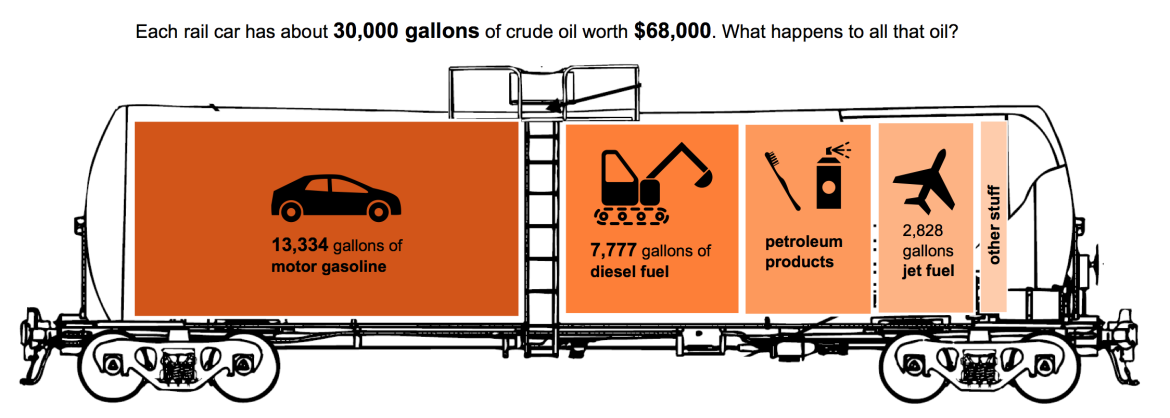
Jordan Wirfs-Brock / Inside Energy
What will happen to all that crude carried on railroads? Much of it will become gasoline, and the rest will turn into diesel, jet fuel and petroleum products. This image used the Backhoe icon designed by Jev Downer from the Noun Project.
Last week, Inside Energy reported that about 408,000 carloads and 39 million tons of crude oil originated on United States railroads in 2013. It’s a lot of oil, and it’s raising a lot of questions about safety. There are a lot of things we still don’t know about crude-by-rail, and Inside Energy is drilling into the details.
How many railroad cars is that?
- An average of 1,119 carloads a day.
- One carload every 77 seconds – roughly the same frequency as coronary bypass surgeries are performed in the U.S.
- About the same number of railroad cars as of LEGO pieces in this jaw-dropping replica of Hogwarts or images in the Metropolitan Museum of Art’s digital collection.
And how much oil does each carload hold?
Crude oil typically travels in cars called DOT-111s. Each car carries roughly 30,000 gallons of crude oil. When that crude oil is processed, a little under half – 13,433 gallons – of it will become gasoline you can put in your car. With that much gasoline, you could drive a Ford F-150 – America’s best selling vehicle for decades – 241,794 miles. That’s back and forth between Los Angeles and New York 89 times. (Or you could drive a 1990 Mercury Sable, my sweet high school ride, for 268,660 miles. To find out how far your car would go, look up your own car’s gas mileage with this tool.)
What happens to the rest of the crude oil? Each rail car will also yield 7,777 gallons of diesel fuel, which is used to power agricultural and construction equipment, boats, trucks and generators. Some of that crude will also get made into jet fuel – about 2,828 gallons of it, enough to fly a Boeing-747 from Washington, D.C. to Chicago.
The rest of the crude will be used to make lubricants, asphalts, plastics, crayons, deodorant and tires, among other things.
What is each one of oil-filled those cars worth?
Crude currently sells for $96 a barrel, so the oil in a single car is worth $67,872. Railroads aren’t getting all that money, of course, because they are just transporting the oil. Based on data from the Surface Transportation Board, railroads make about $3,153 per car – $2.1 billion dollars for the entire crude-by-rail industry last year.
Data Notes:
- How did we calculate the amount of crude in each car? New regulations for railroad companies carrying Bakken apply to trains, “containing more than 1,000,000 gallons of Bakken crude oil, or approximately 35 tank cars.” 1,000,000 gallons / 35 cars = 28,571 gallons / car. Or, looking at the national numbers, 408,302 cars carry 39,263,515 tons, which works out to 96 tons per car. One barrel of oil weighs about 0.136 metric tons, so that’s about 707 barrels of crude in each car. A barrel of crude is about 42 gallons, so that’s 29,696 gallons per car. These numbers are reasonably close, which is a good sanity check.
- Airplane fuel efficiency varies greatly depending on how full the plane is, the weather, and other factors, but we used a rough estimates of five miles per gallon.








